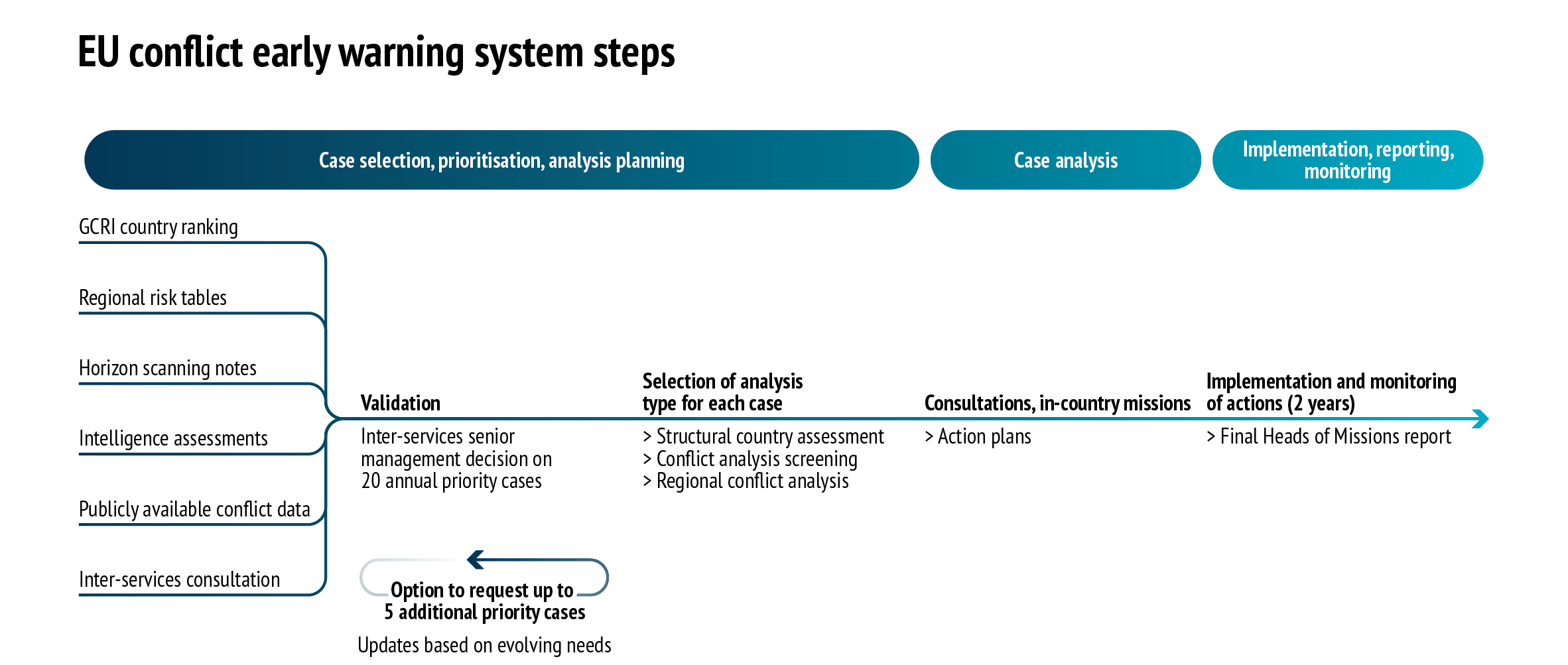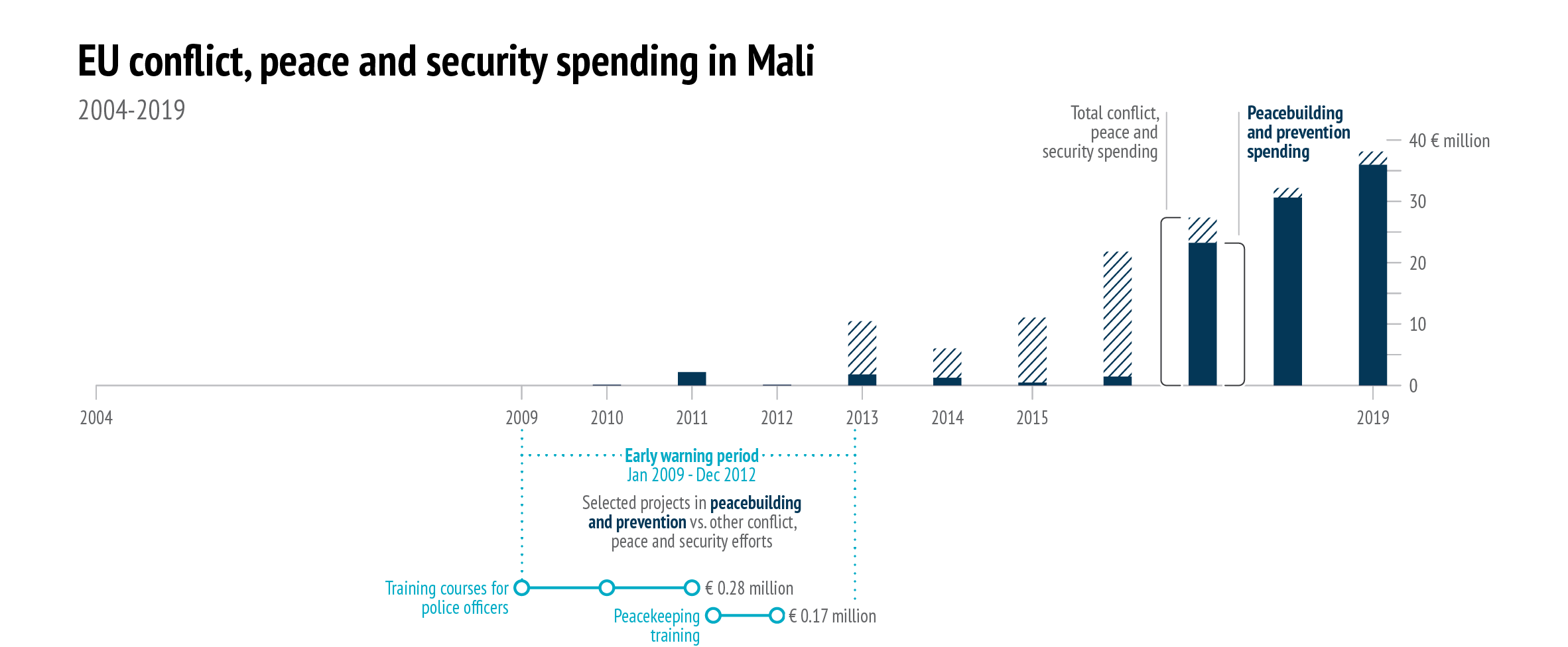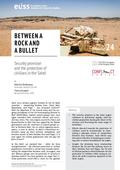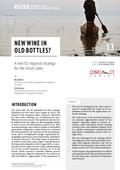You are here
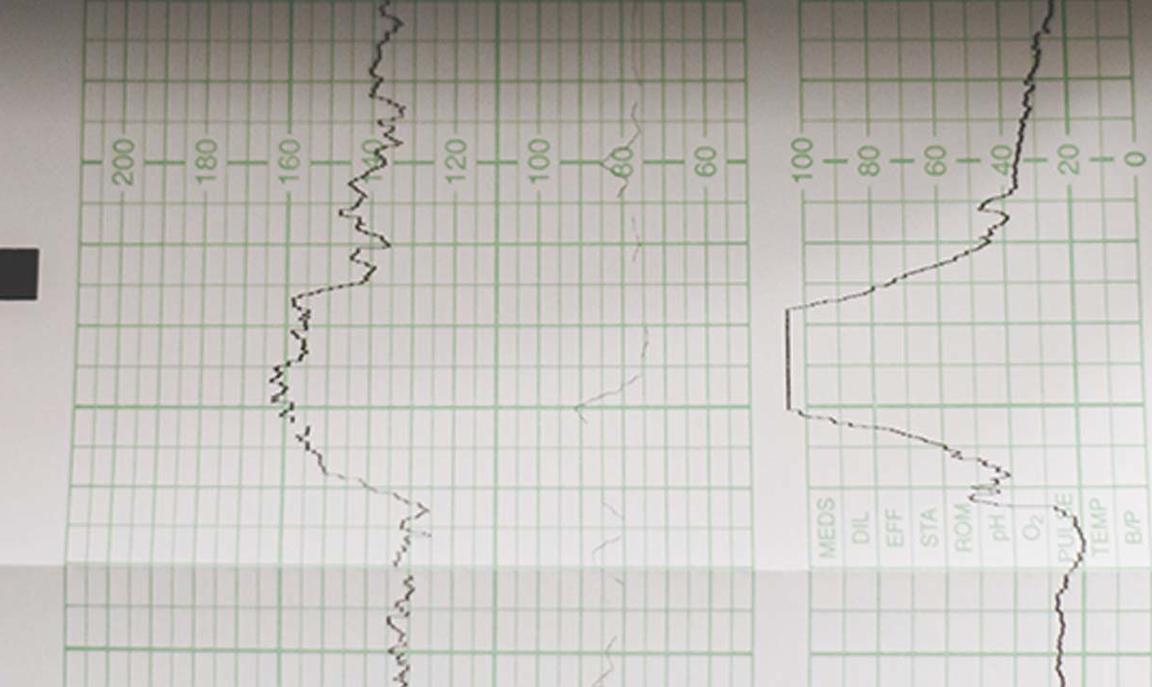
The power and limits of data for peace
Introduction

Preventing violent conflict and fostering peace are the European Union’s main foreign policy goals – particularly regarding its immediate neighbourhood (1). The recent escalation of violence in places like Ukraine, Mali and Sudan begs the question of whether the EU’s conflict prevention mechanisms are effective and how they can be strengthened.
To help avoid deadly violence and its consequences in the future, the EU needs to assess where risks for violence loom and how they can be reduced before violence escalates. Since 2012 it has done so with the help of its conflict early warning system (EWS), which has recently been updated as the toolset on EU conflict analysis and early warning. The toolset is one of the rare examples of a system that integrates data-driven conflict forecasting with traditional qualitative and intelligence assessments. The process combines in-depth analysis, political prioritisation, and planning of preventive engagement in countries at risk. In combination with other tools, the system is designed to improve the EU’s efforts towards conflict prevention and peacebuilding outside the Union (2).
This Brief analyses the EU warning system’s contribution to conflict prevention and discusses ways to strengthen it. The first section examines the factors that contribute to the success of the system. The second section suggests how the system and the EU’s overall prevention approach can be further improved. Both sections hold lessons for developers of risk assessment and warning systems within and outside EU institutions. The Brief concludes by arguing that the European External Action Service (EEAS) should focus on expanding the methodological toolbox to include innovative foresight approaches. Together with the EU Commission, Member States and other partners, it should strengthen the link between warning and action to make sure analyses translate into meaningful, coordinated prevention.
Lessons from the EU's conflict early warning approach
From national governments to regional organisations and UN agencies, many bodies try to harness the power of data to predict conflict and violence in order to prevent them (3). These efforts started well before advanced computational analytics like large language models (ChatGPT) were accessible to the broader public. With the increasing prevalence of data tools and open-source intelligence techniques (OSINT), the pressure on public institutions to keep up with developments in the private sector and use data and technology ‘for good’ is mounting (4).
Excessive faith in the accuracy of datadriven forecasts reflects optimism in technological solutions to political problems.
Among experts, the EU’s conflict early warning system is frequently referenced as a good example of how to combine conflict forecasting based on publicly available data with qualitative and intelligence assessments, in-country analysis missions, political prioritisation of conflict risk cases and options for preventive action (5). From an outside perspective, several success factors of the EU EWS stand out.
Matching the 'early action' with the appropriate timeline and methods
While foresight is commonly used as an umbrella term for efforts to foresee a variety of plausible future courses of action, forecasting methods are designed to predict the future as accurately as possible (6). Expectations vis-à-vis conflict prediction often fall into one of two extremes: profound scepticism about efforts to predict the future or disproportionate confidence that forecasting methods will accurately predict precisely when and where a conflict episode will occur. The former is the result of alleged surprises like the uprisings in the Arab world in the early 2010s – which were actually not so surprising to analysts of the region. These upheavals resulted from several long-standing risk factors like poverty and scarcity in combination with trigger events. In contrast, excessive faith in the accuracy of data-driven forecasts reflects optimism in technological solutions to political problems. It is rarely possible to produce precise warnings of, for example, an imminent outbreak of violent conflict and its reasons, including ways to prevent it from happening. Nevertheless, data-driven methods do offer ways to assess levels of risk for violence and ways to counter them.
To be successful, an early warning system needs to first and foremost define options for early action and then choose the right analytical instruments and timeframe for analysis. This is a key lesson from experiences with flood and storm early warning systems, in which warnings are followed by the early release of humanitarian funds for disaster response (7). Counterintuitively, organisations often start building data analysis teams without clearly defining the type of action their models are supposed to inform. The EU EWS successfully matches long-term preventive instruments – such as youth employment, education or poverty reduction programmes – that tackle structural risk factors for violent conflict with a data model that assesses these risks in the coming 1-4 years (8).
The warning system annually identifies, prioritises, and assesses risks and flags up conflict prevention and peacebuilding opportunities for the EEAS, EU Commission Directorate-Generals and Services and delegations in countries at risk. Responses can include, among other things, diplomatic initiatives and mediation, or development and economic assistance (9). This approach is unique because the EU is the only organisation that links a multi-method conflict risk assessment to adjustments of action across such a broad spectrum of policy domains that can contribute to prevention.
Acknowledging analytical limitations and the need for political decisions
Designers of early warning systems commonly struggle with the integration of data-driven and more traditional qualitative sources, and with defining the point at which a political decision needs to complement analytical results. The EU system currently succeeds at this. The statistical forecasts at the beginning of each annual early warning cycle – the Global Conflict Risk Index (GCRI) – use publicly available data about factors known to impact conflict risk in countries outside the EU (10). These include, for example, the level of democracy and repression, income inequality, infant mortality, and corruption, information about which is used to estimate the risk of violent conflict. The result is a ranking of countries according to the probability of violence multiple years ahead. At the top of this list are countries experiencing an ongoing war, for example Yemen, as recent levels of conflict tend to be the strongest predictor of future violence.
Data: European Commission, Joint Staff Working Document SWD (2023), 295 final
This result is only part of the picture. The statistical model heavily relies on the predictive power of variables such as past and neighbouring conflicts. It cannot account for very recent events and conflict triggers such as newly formed military alliances. To compensate for this deficiency, the results are combined with qualitative and intelligence assessments, including by the EU’s Intelligence and Situation Centre. They focus on factors like regional dynamics and so-called hybrid threats, as well as sources beyond the publicly available structural data of the quantitative model.
The decision on priority cases for prevention ultimately remains political. After the full assessment, EEAS and Commission senior management at directors level receive a long list of 20 cases and decide on 10 conflict considering the EU’s political interests, leverage and complementarity with other actors (11). They then inform Member States via the EU Council Political and Security Committee (PSC). Such a prioritisation exercise by senior management based on defined criteria is something many other early warning systems struggle to achieve.
Turning prevention and working with data into habits
A frequently cited advantage of the EWS is that it makes thinking about prevention a regular exercise for staff, helping to establish a ‘preventive mind-set’ (12). Once a country is identified as high-risk, an in-depth shared assessment phase is initiated that draws on geographic and thematic experts from across the EEAS and Commission and beyond to analyse risks and options for preventive action.
Engaging with the quantitative results of a statistical model has effects on the working culture and capacities of an institution. Diplomatic and intelligence services around the world need to find ways to incorporate so-called artificial intelligence like large language models and remote sensing analysis into their workflows to stay on top of developments (13). Understanding detailed results of a forecasting model like the GCRI already poses challenges in a context that has no tradition of working with quantitative data. But it is an important starting point that will facilitate the inclusion of other data analyses and data science capacities in foreign policy processes and workflows and finding ways to deal with the challenges that follow, including how to visualise results and communicate them to decision-makers.
Regularly reassess, refine and readjust
Lessons learned and evolving realities have led the EU to reassess and adjust its approach to early warning, analysis and prevention (14). The EEAS has added a qualitative horizon scanning process, which is more focused on immediate political and security developments that may lead to instability over a shorter timeline of six months into the future. It builds on sources like in-house media monitoring and briefings by conflict experts. This allows an awareness of, and potential response to, dynamic situations – such as the escalation of violence in Sudan in April 2023 – about six months ahead of time on the horizon scanning radar.
The EU’s warning system is a good example of successful science-policy cooperation.
Since September 2023, an update to the early warning and conflict analysis toolset is aimed at better integrating existing conflict analysis and conflict early warning tools in three phases (15): (i) the selection of early warning and conflict analysis priority countries or regions; (ii) the selection and undertaking of in-depth analyses for each case; and (iii) the implementation and monitoring of the situation, including preventive activities. In the future, country assessments, conflict analysis screenings or regional conflict analyses with thematic priorities can be requested for additional cases on an ad-hoc basis, in addition to the ten annually selected. Furthermore, countries can be dropped from the cycle if developments make them less of a prevention priority (16).
This recent update creates room for adaptation during the two-year warning cycle – which is both an opportunity and a risk. In the past, the system has been a valuable counterweight to political crises of the day, which pull policymakers’ attention in various directions. It has helped ensure that news headlines do not completely supersede the results of analyses designed to offset institutional biases (17). The new process will ideally complement a thorough analytical approach with an opportunity to react better to current events. Responsible leadership at the EEAS needs to make sure this leads to better calibrated warning and prevention instead of diverting scarce resources away from long-term preventive priorities to crises for which prevention comes too late.
Getting science-policy cooperation right
The EU’s conflict warning system is a good example of successful science-policy cooperation – in this case between EU institutions and the Joint Research Centre (JRC). Since the country risk index (GCRI) only predicts risk for the country level and is only updated once a year, the EEAS and JRC have started developing an additional model for more short-term forecasts of the probability of violent conflict up to six months ahead at the level of regions within a country: the Dynamic Conflict Risk Model (DCRM), which uses more frequently updated data. The goal is to integrate its results into the EWS and the EEAS is currently working on how to do this once the DCRM results are available (18). The GCRI forecasts have also been improved (19).
Methodological choices made during the development of the indices show the advantage of close cooperation between bureaucracy and scientists. For example, the developers calibrated the model to privilege producing ‘false alarms’ over a proclivity to underestimate conflict risks. They decided to produce forecasts for administrative regions instead of an artificial division of countries into grid-cells, which some academics use, to make the results more user-friendly for analysts and diplomatic staff at the EEAS (20). In contrast, the development of predictive systems in some EU Member States has suffered from challenging communication between a diplomatic service and technical experts and from the fact that bureaucracies are not flexible enough to build the necessary technical infrastructure. The EU’s approach of building skilled interdisciplinary teams at the EEAS and JRC which collaborate towards a clear goal has proven successful.
Going forward, the EU needs to ensure it retains specialised talent when diplomatic staff rotates and that it shares lessons learned with other actors. It can do so through investments in science-policy cooperation, for example through the UN-level Complex Risk Analytics Fund (CRAF’d), and by funding the Data for Peace community, which is an indispensable forum for scientists and practitioners to match policy needs with rapidly evolving analytical tools (21).
Remaining challenges and the way forward
Despite the achievements of the EU’s conflict early warning system, the EU’s contributions to conflict prevention are not as substantial as they could be. Changing this will require sustained commitment and support by EU institutions and Member States.
Anticipating new, different and unexpected conflicts
The data-driven elements of the EWS are not good at predicting conflict outbreaks which occur either in places with little or no history of recent violence or where there is no violence in the neighbourhood. Blind spots can be identified and uncovered in two ways: through methodological innovation and by setting incentives for staff at the analytical and decision-making stages of the early warning process.
Methodologically, current predictions remain dependent on an underlying theory of how conflict occurs – in the GCRI case the above-mentioned factors such as poverty, inequality and history of conflict (22). These models follow from research to explain the types of violent conflict policymakers in the West and conflict researchers were primarily concerned with in the 1990s and 2000s. They are therefore good at detecting civil wars that happen under these structural risk conditions, as opposed to other types of conflict – such as a great power’s decision to invade a neighbouring country like Ukraine and the potential ripple effects across other regions. The new DCRM – if put to use – and streamlined analysis processes are important additions, but any full-spectrum risk assessment and early warning process needs complementary methods.
In the long run, the chances of detecting new conflict outbreak and escalation are greater when combined with automated text analysis to predict the rare cases in which a country with a long, peaceful history suddenly experiences violence (23). As the world evolves and priorities shift, the foresight toolbox also needs to adapt. Making sure predictive models are not skewed towards a certain type of conflict is especially relevant as political priorities in large parts of the EU not only include civil wars in Africa, but other types of conflict such as the Russian invasion of Ukraine, a possible war in the Taiwan Strait, or great power conflict. New research on conflict impacts, early signals for escalation and simulation approaches include promising advances to make data-driven forecasts more actionable and relevant (24). The EU can support research in these directions.
In addition, scenario-building exercises focused on discerning high-impact, underrated risks are even better suited to identify and fill the blind spots of human analysts (25). Such exercises ideally involve people with diverse viewpoints unencumbered by institutional constraints and benefit from the participation of decision-makers to produce results that they see as legitimate. The EEAS currently uses scenario analysis on already prioritised countries or regions but not for the purpose of selecting priority cases. In the earlier stages of risk assessment, the responsibility for detecting so-called weak signals and covering the blind spots of current analysis largely lies with the intelligence assessments that feed into the EU warning and analysis system. From the outside, their quality can hardly be assessed. As public scepticism about the state of intelligence sharing and cooperation within the EU abounds, the European Parliament needs to fulfil its oversight function to make sure anticipatory analysis tools are used as much as possible, for example ensuring a structured assessment and comparison of different analytical sources and methods’ predictive performance and added value (26).
Beyond methodology, senior management need to analyse the incentives and obstacles each involved individual faces in their effort to deliver effective warning and reaction. (27) The latter include, for example, homogenous teams which reinforce each other’s biases due to the lack of a culture of openness or dissent throughout the decision-making hierarchy. Enabling analysts to circumvent hierarchical structures at the right moments and engaging critically with dissenting opinions has been identified as a key factor for successful warning within the EEAS in the past (28).
More structured and disciplined assessments
The numerical results of the GCRI help structure risk assessments and discussions about priorities. Analysts describe them as a largely objective basis that helps advocate for prevention with solid evidence (29). To level the playing field and make well-informed decisions, institutions should encourage structured assessment processes for qualitative inputs as well.
As the world evolves and priorities shift, the foresight toolbox also needs to adapt.
Individual analysts need to compare and integrate highly structured numerical coefficients with much less harmonised judgement of risk by experts with deep geographical or thematic expertise. While the predictive power of computational models is evaluated with mathematical metrics, human analysts are rarely required to express their assessments in standardised terms. Leadership needs to make sure decisions do not depend on the level of individual persuasiveness more than the weight of the evidence (30).
Data: Office of the Director of National Intelligence, ‘Background to “Assessing Russian Activities and Intentions in Recent US Elections”: The analytic process and cyber incident attribution’, January 2017
Intelligence researchers recommend strengthening structured assessments, for example expressing assessments in percentages of likelihood (31). Research on foreign policy analysis and predictions suggests that introducing quantitative probability assessments can improve the precision and usefulness of judgements without the need for extensive specialised methodology training (32). Introducing this may seem unnecessarily complex, with some analysts saying that 51% per cent risk or ‘more likely than not’ is the only threshold that matters (33). But without knowledge about how (in)accurate an assessment was, it is hard to improve it. To change this, institutions can learn from quantitative prediction scholars, who have developed a range of metrics for accuracy and uncertainty, and they can make sure structured assessments from a variety of sources are regularly evaluated in-house. Better comparability of different inputs and overall results will allow for better-informed decision-making. Structured quantitative assessments are not in contradiction with narrative approaches such as scenario-based foresight. They can and should be sequenced and combined, with each method fulfilling a distinct purpose for holistic risk assessment.
Getting from warning to action
In the end, any early warning system can only be as good as the preventive action that it initiates. The EU system’s implementation and monitoring phase involves missions in the priority countries, a reassessment of ongoing EU engagement towards the respective country and the development and implementation of new preventive activities (34). Compared to the sophisticated multi-method prioritisation and analysis process, the effectiveness of implemented preventive measures remains the greatest shortcoming.
Any early warning system can only be as good as the preventive action that it initiates.
For more than two years after identification, a prevention priority country stays on the EU’s radar to improve policies and programming against the background of risks across a range of areas including development, humanitarian assistance and trade (35). However, the follow-up mechanisms to ensure preventive action after extensive analysis are weak. EU country delegations are required to report on their actions, but there is usually no extra budget made available or binding requirements to make sure country teams act on the EU EWS’ recommendations.
The EEAS and Commission should analyse why recommendations emerging from the warning mechanism are not taken more seriously by EU policymakers.
Most of the funding labelled as prevention by the European Union and Member States does not go into actual prevention, but into managing acute crises. This runs completely counter to the logic of structural long-term prevention against latent risks (36). For example, crisis prevention spending for Georgia did not react to concrete external warnings of war prior to 2008 and efforts were only scaled up after the war broke out. Similarly, no serious preventive efforts were made towards Mali ahead of the 2012 crisis, or towards Burkina Faso before 2015, with EU investments only increasing from 2016 onwards in the latter case (37). Engagement largely follows headlines and events instead of a concerted preventive effort at significant scale.
Data: Rotmann, P., Li, M. and Stoffel, S., ‘Follow the money: Investing in crisis prevention – What the spending patterns of Germany, the United States, the United Kingdom, and the European Union reveal about strategies and priorities’, Global Public Policy Institute, October 2021. Adaptation from GPPi/Ilja Sperling, CC BY-SA 4.0
Garnering support for preventive action faces an in-build conundrum: when prevention is successful its effects often go unseen. That is, if the crisis does not happen, nobody believes it was imminent or that the preventive engagement made the difference. As the cases the EU has selected as prevention priorities in its early warning system are not made public, spending can currently only be assessed against publicly available warnings. A fair evaluation of the EU’s preventive action would need to consider how well spending has been adjusted to the results of the early warning system’s recommendations.Transparent assessments are key to ensuring that preventive measures do not only pay off in terms of reducing violence, but are supported by voters in EU Member States. They are the ones who ultimately need to support foreign policy engagement and trust processes that include algorithms in political decision-making.
It is tempting to attribute any gap between early warning and timely action to a lack of political will on the part of decision-makers. But domestic audiences cannot expect decision-makers to react to vague warnings from unclear sources. Instead, research on effective warnings shows that those who sound the alarm on an impending crisis need to be credible and trustworthy and take into account the constraints and trade-offs decision-makers face (38).
To better bridge the gap between warning and action, the EU can learn from humanitarian aid agencies, which link forecasts to clear pre-agreed anticipatory action protocols and pre-committed financing instead of vague and non-binding recommendations for action (39). While long-term structural prevention is different from immediate disaster assistance, forecast-based action protocols with appropriate financing could be adjusted to activities with a longer lead-time.
Conclusion
While many governments and international organisations have struggled to set up an effective system to identify and analyse conflict risks in the future, the EU’s conflict early warning system has succeeded in establishing a functioning process for in-depth risk analysis. This is encouraging, because it shows others what is possible.
Going forward, the priority for EU policymakers should be to strengthen the link between early warning and preventive action. The EEAS and Commission should analyse why recommendations emerging from the warning mechanism are not taken more seriously by EU policymakers and delegations around the world – and how they can make the system more resilient against the political forces that hinder the EU from being a more constructive, coherent voice for peace. As this Brief has argued, anticipatory action protocols with pre-committed funding, as used in the humanitarian sector, can be adapted to conflict prevention needs to ensure that analysis is followed by action.
Future updates to the EU’s conflict analysis and conflict early warning toolset should consider rapid methodological developments and a shifting risk landscape. Methodologically, additional forecasting models and foresight techniques can help strengthen and expand the analytical basis to account for different types of risk. While the system is currently mainly designed to assess risk of civil war and violence outside the EU, it could serve as a model for a more extensive tool to assess security risks and develop recommendations for action – including, for example, foreign influencing operations and critical economic dependencies (40).
At the same time, the EU can support research that examines when warnings are successful and how decision-makers react to various types of future-oriented risk assessment (41). It can do so, for example, through Horizon Europe research grants and an openness to cooperate with researchers in residence, and by supporting the Data for Peace and early warning communities of practice to sustain exchange and cooperation. These investments into ‘what works’ in prevention, analysis, and warning will be key to move the prevention agenda forward in the face of climate-related pressures on regions prone to violent conflict in the EU’s neighbourhood.
References
1. Council of the European Union, ‘Council conclusions on conflict prevention’, 20 June 2011 (https://www.consilium.europa.eu/uedocs/ cms_data/docs/pressdata/EN/foraff/122911.pdf)
2. See Bressan, S. and Bergmaier, A., ‘From conflict early warning to fostering resilience? Chasing convergence in EU foreign policy’, Democratization, Vol. 28, No 7, 2021, pp. 1357-1374 (https://doi.org/10.1 80/13510347.2021.1918108); European Commission, ‘Joint Staff Working Document - Updated toolset for EU Conflict Analysis and Conflict Early Warning Objectives, processes and guidance’, SWD (2023) 295 final, 5 September 2023 (https://data.consilium.europa.eu/doc/document/ST- 12580-2023-INIT/en/pdf); European Commission, ‘Joint Staff Working Document – EU conflict Early Warning System: Objectives, process and guidance for implementation – 2020’, 10 March 2021 (https://www.eeas. europa.eu/sites/default/files/jswd_eu_early_ews_from_vista.pdf).
3. See, for example, The Complex Risk Analytics Fund (https://crafd.io/); Panic, B., Can Emerging Technologies Lead a Revival of Conflict Early Warning/Early Action? Lessons from the Field, NYU Center on International Cooperation, New York, 2022 (https://cic.nyu.edu/resources/can- emerging-technologies-lead-a-revival-of-conflict-early-warning- early-action-lessons-from-the-field/); ‘From conflict early warning to fostering resilience? Chasing convergence in EU foreign policy’, op.cit.
4. European Commission, ‘Open-source intelligence’, 2 May 2022 (https:// data.europa.eu/en/publications/datastories/open-source-intelligence); Harrington, J. and McCabe, R., ‘Modernizing intelligence, surveillance, and reconnaissance to “find” in the era of security competition’, Center for Strategic and International Studies, 6 August 2021 (https:// www.csis.org/analysis/modernizing-intelligence-surveillance-and- reconnaissance-find-era-security-competition); Gesprächskreis Nachrichtendienste in Deutschland e.V., ‘Künstliche Intelligenz und Nationale Sicherheit Potentiale von GEOINT und Predictive Intelligence’, 19 April 2021 (https://www.gknd. org/uploads/1/3/8/1/138195092/210419_gknd_stellungnahme_ ku%CC%88nstliche_intelligenz_und_nationale_sicherheit.pdf).
5. Deen, B., Stoetman, A. and de Bruijne, K., From Indices to Insight: A proposal to enhance the risk assessment of the Dutch Early Warning/Early Action process, Clingendael Report, November 2021 (https://www.clingendael. org/sites/default/files/2021-11/Report_Early_warning_early_action_ Nov_2021.pdf).
6. Bressan S. and Rotmann P., ‘Looking Ahead: Foresight for crisis prevention’, EU-LISTCO Policy Paper Series No. 3, July 2019 (https:// www.gppi.net/media/bressan_rotmann_2019_EU-LISTCO-POLICY- PAPERS_03.pdf); Scoblic, J. P., ‘Strategic Foresight in U.S. Agencies.’ New America, 2021.
7. Wagner, M. and Jaime C., ‘An agenda for expanding forecast-based action to situations of conflict’, Working Paper, GPPi, September 2020 (https://www.gppi.net/media/Wagner_Jaime_2020_FbA-in-Conflict- Situations.pdf).
8. European Commission, ‘Joint Staff Working Document - Updated toolset for EU Conflict Analysis and Conflict Early Warning Objectives, processes and guidance’, op.cit.; European Commission, ‘Joint Staff Working Document – EU conflict Early Warning System: Objectives, process and guidance for implementation – 2020’, op.cit.
9. Ibid.
10. Halkia, M., Ferri S., Schellens, M. K., Papazoglou, M., and Thomakos, D., ‘The Global Conflict Risk Index: A quantitative tool for policy support on conflict prevention’, Progress in Disaster Science, Vol. 6, April 2020 (https://doi.org/10.1016/j.pdisas.2020.100069); European Commission – Joint Research Centre, ‘The Global Conflict Risk Index 2022: Revised data and methods’, Publications Office of the European Union, 2022 (https:// doi.org/10.2760%2F041759).
11. European Commission, ‘Joint Staff Working Document - Updated toolset for EU Conflict Analysis and Conflict Early Warning Objectives, processes and guidance’, op.cit.
12. Interview with EEAS conflict advisor, Podcast ‘Krisen von morgen’, Episode 4, ‘Vorausschau und Frühwarnung in der EU’, 49security, November 2022 (https://fourninesecurity.de/podcast).
13. Mueller H. and Rauh C., ‘Reading between the lines: Prediction of political violence using newspaper text’, American Political Science Review, Vol. 112, No 2 , 2018 , pp. 358 – 375; Racek, D., Thurner, P.W., Davidson, B.I., Zhu, X.X. and Kauermann, G., ‘Conflict forecasting using remote sensing data: An application to the Syrian civil war’, International Journal of Forecasting, May 2023 (https://doi.org/10.1016/j.ijforecast.2023.04.001).
14. European Commission, ‘Joint Staff Working Document - Updated toolset for EU Conflict Analysis and Conflict Early Warning Objectives, processes and guidance’, op.cit.
15. Ibid.
16. Ibid.
17. Interview with EEAS conflict advisor, Podcast ‘Krisen von morgen’, Episode 4, op.cit.
18. Thomakos, D., Jenkinson, G., Papazoglou, M., et al., ‘Dynamic Global Conflict Risk Index’, European Commission Joint Research Centre, Publications Office of the European Union, 2019 (https:// doi:10.2760/846412).
19. ‘The Global Conflict Risk Index 2022: Revised data and methods,’ op.cit.
20. Conversation with EU JRC.
21. See website of Complex Risks Analytics Fund (https://crafd.io/who- we-are#:~:text=The%20Complex%20Risk%20Analytics%20Fund%20 (CRAF’d)%20is%20the,the%20data%20that%20saves%20lives; https://cic.nyu.edu/events/data-for-peace-leveraging-data-to-foster-lasting- peace/).
22. The JRC is already exploring ways to integrate additional data sources to improve the chances of predicting the next big new conflict we might not see coming.
23. See, for example, Conflict Forecast – The Project (https://conflictforecast. org/about); Malaga A., Mueller H., Rauh, C., Ruggieri, A. and Seimon,B., ‘Dynamic Early Warning and Action Model: A policy evaluation tool’, 2023; ‘Reading between the lines: Prediction of political violence using newspaper text’, op.cit.; Interview on conflict prediction with Christoph O. Meyer, Podcast ‘Krisen von morgen’, Episode 3, ‘Gewalt verstehen und vorhersagen’, 49security, November 2022 (https://fourninesecurity.de/ podcast).
24. Center for International Cooperation, ‘Assessing + mapping conflict exposure worldwide in real time; Peace & transition process tracker’ 2023 (https://www.youtube.com/watch?v=R6Wq9GQ02lw&list=PLh9Xp7DYZR YE4OXeX5_mtj3xdendjgreb&index=16&ab_channel=CenteronInternation alCooperationatNYU).
25. ‘Looking Ahead: Foresight for crisis prevention’, op.cit.; Gaub F., ‘Introduction’, in ‘What If...? Scanning the horizon: 12 scenarios for 2021’, Chaillot Paper No 150, EU Institute For Security Studies, February 2019 (https://www.iss.europa.eu/sites/default/files/EUISSFiles/ CP_150_0.pdf).
26. Seyfried, P., ‘A European Intelligence Service? Potentials and limits of intelligence cooperation at EU level’, Federal Academy for Security Policy, Working Paper 20/2017 (https://www.baks.bund.de/en/working-papers/2017/a-european-intelligence-service-potentials-and-limits-of-intelligence).
27. Ikani, N. and Meyer, C. O., ‘The underlying causes of strategic surprise in EU foreign policy: a post-mortem investigation of the Arab uprisings and the Ukraine–Russia crisis of 2013/14’, European Security, Vol. 32, No 2, November 2022 (https://www.tandfonline.com/doi/full/10.1080/0966283 9.2022.2140009); Meyer, C. O., De Franco, C. and Otto, F., Warning about War: Conflict, persuasion and foreign policy, Cambridge University Press, 2019.
28. Interview on crisis early warning with Christoph O. Meyer, Podcast ‘Krisen von morgen’, Episode 5, ‘Ausblick: Krisen(prävention) von morgen’, 49security, November 2022 (https://fourninesecurity.de/ podcast).
29. Interview with EEAS conflict advisor, Podcast ‘Krisen von morgen’, Episode 4, op.cit.
30. Martin S. and Marks, J., Messengers: Who we listen to, who we don’t, and why, Random House, 2019, as mentioned by Florence Gaub on ‘Krisen von morgen’, Episode 4 (https://fourninesecurity.de/podcast).
31. Mandel, D. R. and Barnes, A., ‘Accuracy of forecasts in strategic intelligence’, Proceedings of the National Academy of Sciences, Vol. 111, No 30, July 2014, pp. 10984–89 (https://doi.org/10.1073/pnas.1406138111); Mandel, D. R. and Irwin, D., ‘Tracking accuracy of strategic intelligence forecasts: Findings from a long-term Canadian study’, Futures & Foresight Science, Vol. 3, Nos 3–4, 2021 (https://doi.org/10.1002/ffo2.98).
32. Friedman, J.A. et al, ‘The value of precision in probability assessment: Evidence from a large-scale geopolitical forecasting tournament’, International Studies Quarterly, Vol.62, No 2, June 2018, pp.410-22 (https:// scholar.harvard.edu/files/rzeckhauser/files/value_of_precision.pdf).
33. See University College London, ‘Warning about attacks; The effectiveness of warning processes in foreign & national security policy’, September 2023 (https://www.youtube.com/watch?v=_3UR8wNTWnk&list=PLEsHep Dg9WehzR59WaQ7AzDo-I4hW9sHD&index=4).
34. European Commission, ‘Joint Staff Working Document - Updated toolset for EU Conflict Analysis and Conflict Early Warning Objectives, processes and guidance’, op.cit.
35. Ibid.; Council of the European Union, ‘Council conclusions on conflict prevention’, op.cit.; European Commission, ‘Joint Staff Working Document – EU conflict Early Warning System: Objectives, process and guidance for implementation – 2020’, op.cit.
36. Rotmann P., Li M. and Stoffel, S., ‘Follow the money: Investing in crisis prevention – What the spending patterns of Germany, the United States, the United Kingdom, and the European Union reveal about strategies and priorities’, Global Public Policy Institute, October 2021 (https:// followthemoney.gppi.net/#main).
37. Ibid.
38. Meyer, C. O., ‘Warning about conflicts and pandemics: How to get heard by decision-makers’, PeaceLab Blog, 24 June 2020 (https://peacelab. blog/2020/06/warning-about-conflicts-and-pandemics-how-to-get- heard-by-decision-makers); Meyer, C. O., De Franco, C. and Otto, F., Warning about War: Conflict, persuasion and foreign policy, op cit.
39. See ‘An agenda for expanding forecast-based action to situations of conflict’, op.cit.; United Nations Office for the Coordination of Humanitarian Affairs (OCHA), ‘What are the first steps?’ (https:// anticipatory-action-toolkit.unocha.org/first-steps/).
40. European Union, ‘Joint Communication to The European Parliament, The European Council and The Council on “European Economic Security Strategy”’, JOIN(2023) 20 final, 20 June 2023 (https://eur-lex.europa.eu/ legal-content/EN/TXT/PDF/?uri=CELEX:52023JC0020).
41. Gleditsch, K. S., ‘One without the other? Prediction and policy in international studies’, International Studies Quarterly, Vol. 66, No 3, September 2022 (https://doi.org/10.1093/isq/sqac036).
